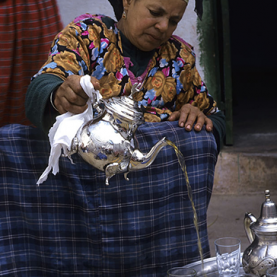A time of family conviviality
Ramadan is not just about depriving oneself of food, it is also a matter of taste. During Ramadan, the day is devoted to asceticism, strictly forbidding eating, drinking and addictive or pleasurable pursuits. Night, however, is a time of conviviality and sharing with family and friends, where careful attention is paid to the purity of the food served in iftar and suhur, the two night-time meals.
Eating together: Commensality as a precept
The act of ‘eating together’ is advocated in Islamic sources. The Hadith recounts the word of the Prophet Muhammad, and states that “Whoever has food enough for two persons, should take a third and whoever has food enough for four persons, should take a fifth or a sixth for blessing is in Jamma’a (gatherings, being together).”
Preparing for Ramadan
On the one hand, Ramadan is a time for tempering pleasures. On the other, for many practising Muslims it is the opportunity to cook their favourite or traditional dishes. Great care is taken with regard to the choice of food, which must be halal and of good quality. In general, the food is bought during the month before Ramadan. Sales of halal meat are particularly high during this period. Shops and grocery stores display the staples of Muslim cuisine, including rice, dates, candied fruit, semolina and sugar. In some Muslim countries, such as Egypt, products are sold at very affordable prices as they are subsidised by the government. The trend in Western countries is to sell new products targeting the ‘Muslim consumer’, ranging from packets of spices to frozen pizza, all bearing the halal stamp.
Meal to break the fast
At nightfall, the family gathers to break the fast by eating dates and drinking a glass of water. This is said to be how the Prophet Muhammad broke his fast and there are different variations of this practice throughout the Arab world. In Morocco, for example, people eat harira, a soup made from tomatoes, pulses, meat and onions. Those observing Ramadan eat two meals during the night, iftar and suhur. Iftar is the meal eaten at nightfall and is usually composed of a variety of dishes reflecting the socio-economic status of the family. The tables of poorer families feature dishes made from starchy food and cereals, with or without meat, such as falafels, bread, lentil soup and rice. More affluent families prepare dishes based mainly on meat, fish and seafood, such as squid salad, stuffed pigeon or chicken soup. The richness and finesse of the food take precedent over the quantity, as excess must be avoided at all cost. The complexity of the meal often means it needs to be prepared in advance, during the day. Traditionally, women are the ‘guardians of the stoves’ and must ensure they do not swallow any of the food tasted during its preparation, due to the risk of breaking the fast. Suhur, the meal eaten just before morning prayer, is much lighter than iftar. It mainly consists of dairy products such as yoghurts and cheese, together with dates, bread and jam, tea or a glass of milk. Each region and country has its own variations of dishes. In Morocco, people eat rghaif, a stuffed pancake, and in Lebanon, manaïch, a flatbread seasoned with zataar, a blend of thyme and other spices.
Public feasts as an act of generosity
Showing generosity towards others is not limited to the circle of family or friends. Non-governmental associations in Arab countries organise huge free public feasts called mawa’id al-rahman to feed the poor and orphans.
MASSON, Denise, 1967. Coran. Paris : Gallimard.
ASSOULY, Olivier, 2002. Les nourritures divines. Essai sur les interdits alimentaires. Paris : Actes Sud.
CAMPO, Juan E., CAMPO, Magda, 2015. Food and Cuisine. In : The Cambridge Companion to Modern Arab Culture. Cambridge : Cambridge University Press. pp. 268-292.









